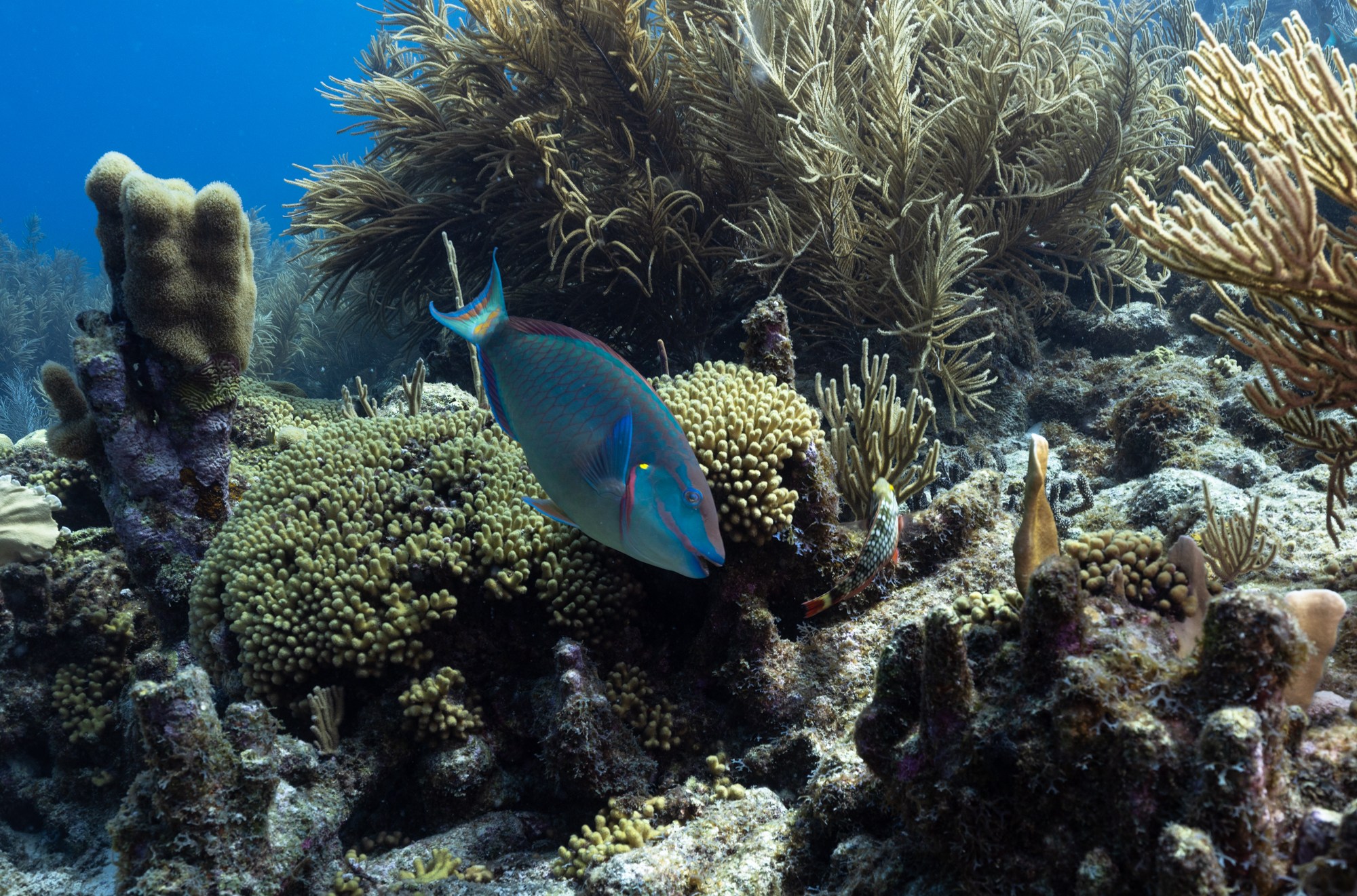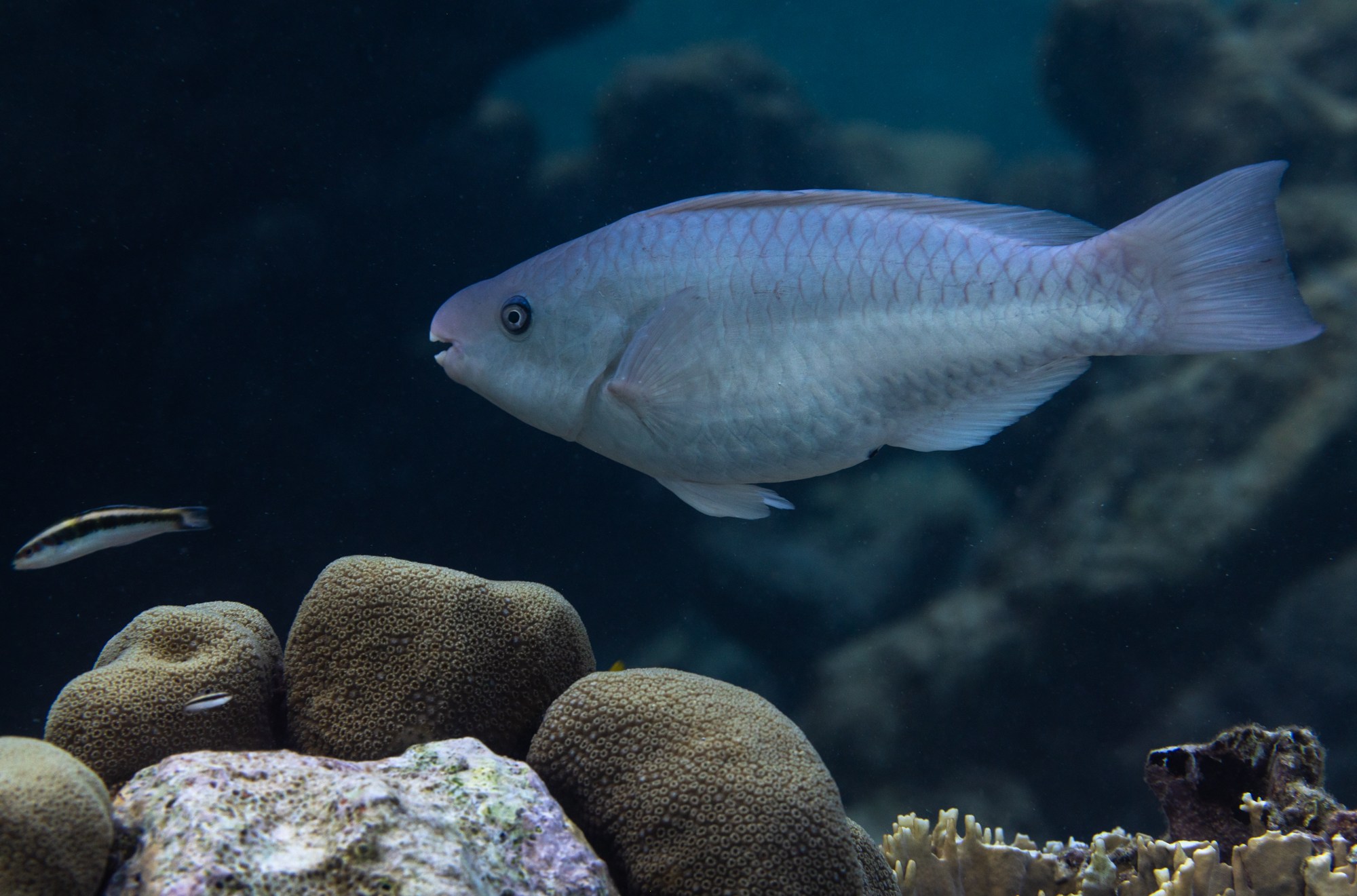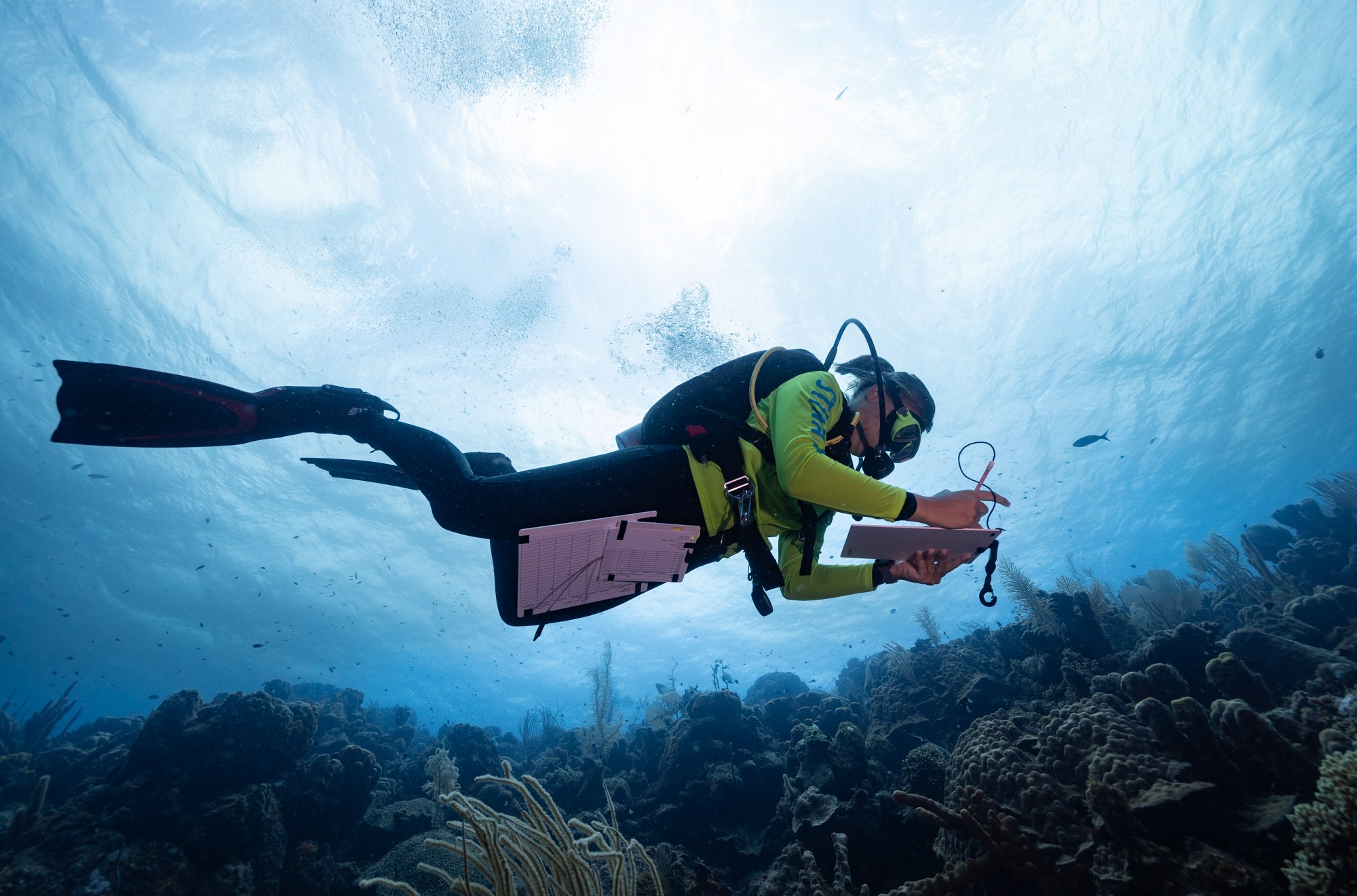The sea is full of wonderful creatures. The parrotfish is no different.
Its teeth are joined in a sharp beak, making it look like a bird. It is hermaphroditic, changing sex in the middle of its life. And when sleeping, some parrot fish wrap themselves in bees.
Strange and unpredictable as it may be, this creature is a true hero of the ocean.
Global warming, various diseases, and coastal development have been killing the world’s coral reefs, the visible ecosystems that support a quarter of all marine life. By one estimate, the world’s coral reef habitat has halved since the 1950s.
But the situation would be worse if there were no parrotfish.

Jenny Adler

Jenny Adler
Parrotfish are excellent hunters at their jobs. As they move around the reef, these animals – which live in oceans around the world – scrape bacteria and algae off the rocks using their beaks. If left unchecked, that algae can grow out of control, breaking down reefs and preventing new corals from growing. And that makes it difficult for coral reefs to recover after, say, extreme ocean temperatures that kill a coral reef. So where you find hungry parrotfish, coral has more room to grow.
The problem is that, on many reefs, the number of parrotfish – and especially the largest in the Caribbean – is low. Some algae grazers like sea urchins, however, have disappeared, too. Some scientists say that this is the reason why the Caribbean seas failed to recover following the impact of the weather such as hurricanes; there is too much algae for the coral to grow again.

On the flip side, these forces offer little hope for a seemingly doomed ecosystem: By saving parrotfish, as well as trying to control global warming, countries may have a better shot at saving reefs.
If there’s one thing they know about coral reefs it’s that they’re rich colors of blues, reds, pinks, and oranges.
But mostly, one color starts to dominate: green.

Along with the decline of coral reefs is the rise of algae, or seaweed. When corals die, this green, plant-like organism grows rapidly over their bones. And as they spread, those seaweeds can prevent corals from growing back.
Baby corals, who start their lives swimming in the ocean, need a little bit of bare rock to grow and become adults. When the sea floor is covered with algae, larval coral has nowhere to grow. Seaweed can also produce chemicals that harm corals and, when they grow in large numbers, they shade out the rocks.
“The biggest enemy of corals is seaweed,” said Nancy Knowlton, a marine scientist and author, formerly of the Smithsonian National Museum of Natural History. “It goes without saying that reefs will recover better if they don’t come into contact with a lot of seaweed.”
Research shows that in the last 50 years or so, algae has increased in coral reefs around the world, and especially in the Caribbean.
Algae thrive on human waste, such as sewage, and runoff from agricultural fields. This water pollution is full of nutrients like nitrogen and phosphorus that algae need to grow. So as it runs into the ocean, the algae explodes.
Also, one of the biggest algae eaters, the long black sea urchin, started to die off in the Caribbean in the 1980s, probably from water pollution. Caribbean reefs lost, on average, more than 90 percent of their urchins in a few weeks, and those populations have not recovered.

Now, the important task of covering the algae – to give corals a better shot at growing and recovering from die-offs – has fallen to other plant fish, including parrotfish. In some parts of the Caribbean, parrotfish may be the only thing standing between healthy water and one covered in horrible green gunk.
A parrotfish’s lifestyle often involves munching on rocks and dead coral, grinding it into sand, and releasing it on their backs. Some beaches around the world are made up mostly of parrotfish poop.
It is not at all clear what the parrotfish is eating. Research shows that their main food source is colonies of bacteria including cyanobacteria and other microorganisms that live on rocks, often next to visible sea stacks. Parrotfish may not seek out the ocean itself – substances known to harm coral growth and recovery. But as they feed on the bacteria, they end up removing themselves from the rocks, according to Andrew Shantz, who studies parrotfish at the University of Hawai’i at Mānoa.

“Regardless of what they’re targeting, they end up removing the algae from the rock,” Shantz told Vox. “That gives room for corals to come and live or grow and take over that space.”
It’s like how you would weed the garden before planting the seeds to give your seeds a place to grow.
This article was produced in collaboration with the Pulitzer Center
This is the third story in an ongoing series about the future of coral reefs as they face threats from climate change and disease. It was supported by the BAND Foundation and a grant from the Pulitzer Center.
Read the first two stories here:
Several studies have shown that if you don’t remove large fish including parrotfish from the reef, it gets covered in more algae, and that seems to slow down the growth of some corals. One study in Belize, for example, recorded less algae and more baby corals when parrot fish were around.
Likewise, the 2017 study is in Nature Communications linked parrotfish to reef growth in Panama by examining fossils of fish teeth and coral fragments. The study relied on reef sediment cores: tubes of material taken from the ocean floor that contain pieces of coral, seashells, and animal remains. The cores allowed the researchers to determine the rapid growth of the reef and – by looking at the number and shape of the teeth – how many parrotfish were on the rock.

Studies like these support the simple idea that parrotfish benefit coral reefs, but the relationship between fish and coral is complex and controversial in marine biology. Small parrotfish, for example, do not seem to limit the number of sea urchins, even though there are many of them. Other studies have also failed to find a link between fishing restrictions – which often lead more parrotfish – and lots of algae and live coral. Parrotfish also feed on live coral to some extent, although scientists do not suspect this will cause damage to the reefs.
“The response of parrotfish to water dynamics is not always clear,” said Joshua Manning, a postdoctoral researcher at the University of Colorado Boulder who studies parrotfish. “It’s safe to say that parrotfish are good for reefs.”
What does a reef full of parrotfish look like?
People have been eating parrotfish for centuries in the tropics, and it still happens today in many coastal communities around the world. (They taste like sweet fish, according to a quick Google search). While data on global populations are scarce, it is clear that overfishing has caused parrotfish – and especially large parrotfish, which are favored by fishermen – to decline in some of these regions, such as Jamaica and Micronesia.
This decline has already led to an increase in algae.
But there are also places that have protected parrotfish for decades, where these animals are still abundant and apparently doing their job well. The Dutch island of Bonaire, for example, has banned fishing – a common method of catching parrotfish – since the early 1970s. The island, which is located east of Curacao in the southern Caribbean, also banned the harvesting of parrotfish completely in 2010. Although some of Bonaire’s parrotfish still survive, it has twice the number of parrotfish compared to many other Caribbean reefs, according to a 2018 report by the Dutch Caribbean Nature Alliance, a non-profit.

Jenny Adler

Jenny Adler
All of these parrotfish help reduce the growth of algae on Bonaire’s reef, according to Robert Steneck, a professor emeritus at the University of Maine, who has been studying Bonaire’s reef for more than 20 years. That also helped the coral here to survive, he said. Indeed, although most of the Caribbean corals have died in recent decades from pollution and disease, the reef in Bonaire is still strong; parts of it are still thriving.
What’s more, Bonaire’s reef has been able to recover from large die-offs in the past, according to Steneck’s research. Parrotfish really make this ecosystem more resilient, he said.
The truth is more complicated. There are many reasons, beyond the abundance of parrotfish, why Bonaire’s reef is healthier than other parts of the Caribbean. The island is located below the path of many Atlantic hurricanes, for example. Bonaire’s coral is also not as healthy as it once was. Bleaching has been harming reefs for years. And in the spring of 2023, a wild animal disease began to wipe out and kill hundreds of corals, some of which were hundreds of years old.
Faced with this growing threat, parrotfish can do little. If maAs coral die-offs continue and pollution continues to flow into the ocean, large reefs are overrun by seaweed. Once that happens, parrotfish can’t do much to bring them back to life, Manning said. “At some point, with the intensity and frequency of these disturbances, parrotfish feeding will not be able to keep up,” he said.

However, the reef is still better than many of them. Protecting coral reefs depends, above all, on policies and corporate efforts to cut carbon emissions, but that does not mean that effective fishing regulations do not help.
What the parrotfish shows is that individual parts of the ecosystem matter. Take one piece out and the system starts to fail.
“We have to protect them, even if it’s just to give the rocks a chance,” Manning said. “As long as we have parrotfish, we can have a chance to increase the chance of reefs coming back.”
#poor #fish #works #harder